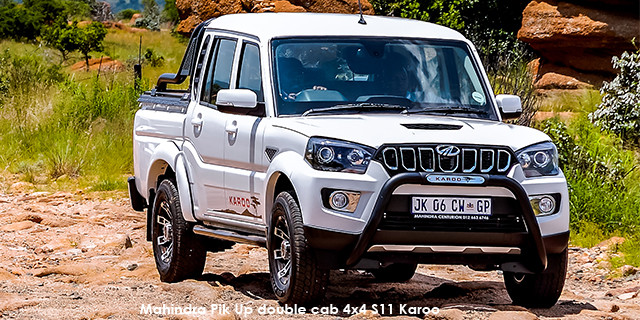
Mahindra has introduced an automatic derivative of the Pik Up. Tested here in Karoo guise, it’s poised to snatch sales from pricier contenders...
For a couple of decades now, the double-cab bakkie has enjoyed great popularity with South African consumers. Its ability to act as a work vehicle during the week and a leisure adventurer on weekends has increased its appeal with those who love the outdoors.
In the last few years, however, manufacturers have truly started offering buyers increasingly upmarket examples crammed full of luxury features. Of course, this makes them expensive, with brands like Mercedes-Benz selling its now-defunct range-topping X350d at a snip under R1 million. While many options in the market aren’t as costly as the X-Class, Volkswagen Amarok or Ford Ranger Wildtrak, some double-cab bakkies are out of reach for numerous buyers, especially those vehicles equipped with an automatic gearbox and all-wheel drive. Spotting a gap in the market, Mahindra introduced an auto derivative of its Pik Up, the S11.
Tested here in Karoo guise, this halo model comes in at a very agreeable price, undercutting its mainstream rivals by a considerable margin. Despite this, the Mahindra is packed with standard features. Specific to the Karoo are custom 16-inch alloys, a branded roll bar and decals festooning the sides of the vehicle. Most appealing is the standard rubberising for the load bay and lockable roller deck.
Inside, you’ll find a seven-inch touchscreen in the middle of the vertical dashboard. Among its features are various media options, vehicle information and satellite navigation. Just below the screen are the climate controls; clearly marked and compre-hensible. Other standard features include cruise control and a reverse camera, along with dual front airbags and ABS with EBD.
Interior space is impressive, with plenty of headroom courtesy of the high roofline. The rear quarters are on par with other vehicles in this segment, offering sufficient legroom. Thanks to the shallow dashboard and slim pillars, the cabin feels suitably airy. From behind the rake-adjustable steering wheel, the driver’s seat affords a commanding view of the road. It’s best to adjust the seat for height before closing the door as the lever is difficult to reach once the door is shut. The front pews are comfortable with sufficient support. Front occupants enjoy individual armrests, while the rear bench makes do with one.
Although the plastics appear hard-wearing, the centre console feels a tad flimsy and the door handles rather insubstantial. We also noted a lack of storage space for odds and ends, with especially narrow door pockets.
On the road, the Pik Up is generally comfortable, the plump 75-profile tyres and supple suspension teaming up to provide an acceptably absorbent ride no choppier than the Isuzu D-Max and Toyota Hilux’s. The 2,2-litre mHawk turbodiesel provides sufficient performance and refinement, fading into the background at a cruise. However, the powertrain on this test unit exhibited an annoying trait when cold: below 2 000 r/min, the engine tended to shudder, as if about to stall. This was particularly noticeable when slowing down for a traffic light or junction and picking up speed again. Aside from that, it pairs well with the Aisin-sourced six-speed automatic; the transmission is smooth and boasts a manual override. This comes in handy when the Mahindra hesitates to kick down.
The Pik Up’s 320 N.m is available from 1 500 to 2 800 r/min, giving it enough in-gear grunt to keep up with traffic. As expected, at higher speeds the S11 starts to struggle, taking 16,53 seconds to accelerate from 120 to 140 km/h. Interestingly, the manual-equipped S10 needed just 13,82 seconds to do the same in fifth gear. In our braking test, the Mahindra required an average of 3,44 seconds to come to a stop from 100 km/h, earning it a “poor” rating. This remains an area in which bakkies stand to improve greatly.
The steering is vague and slow – although no more than you’ll find in many rivals – which, combined with a large turning circle, makes it cumbersome to manoeuvre. Take the Mahindra off-road, however, and the lethargic steering has its benefits. As the Pik Up scales rocks and inclines, the steering wheel responds slowly to the terrain, eliminating much of the usual writhing. Hill-descent control often comes in handy.
Despite Mahindra claiming a rather ambitious fuel economy figure of 7,90 L/100 km, we managed a more realistic 9,80 L/100 km on our fuel run.
TEST SUMMARY
It is eminently capable off-road and the S11 Karoo has plenty of standard equipment at a price that undercuts other bakkies of a similar mechanical configuration. The fact that this once relatively unknown brand is being compared with the likes of Ford and Isuzu speaks volumes about its competency. Still, it remains flawed. Yes, it rides comfortably but the drivetrain isn’t as well sorted as the Ford and Isuzu and the interior is behind its rivals on quality and design.
That said, there’s much to recommend here for buyers looking for an unpretentious workhorse with an impressively engineered auto ‘box to alleviate the strain of commuting. We’d consider the regular S11, which at R15 000 less does without the Karoo’s divisive add-ons.
ROAD TEST SCORE

|

|
Original article from Car
See Full Mahindra Pik Up Double Cab price and specs here










